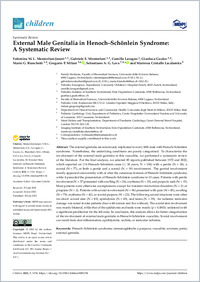External male genitalia in Henoch–Schönlein syndrome : systematic review
- Montorfani-Janett, Valentina M. L. Institute of Family Medicine, Faculty of Biomedical Sciences, Università della Svizzera italiana, Switzerland
- Montorfani, Gabriele E. Institute of Family Medicine, Faculty of Biomedical Sciences, Università della Svizzera italiana, Switzerland
- Lavagno, Camilla Pediatric Emergency Department, University Children’s Hospital Zurich, Switzerland
- Gualco, Gianluca Pediatric Institute of Southern Switzerland, Ente Ospedaliero Cantonale, Switzerland - Faculty of Biomedical Sciences, Università della Svizzera italiana, Switzerland
- Bianchetti, Mario G ORCID Institute of Family Medicine, Faculty of Biomedical Sciences, Università della Svizzera italiana, Switzerland
- Milani, Gregorio P. Pediatric Unit, Fondazione IRCCS Ca’ Granda Ospedale Maggiore Policlinico, Milan, Italy - Department of Clinical Sciences and Community Health, Università degli Studi di Milano, Italy
- Lava, Sebastiano A. G. Pediatric Cardiology Unit, Department of Pediatrics, Centre Hospitalier Universitaire Vaudois and University of Lausanne, Switzerland - Heart Failure and Transplantation, Department of Paediatric Cardiology, Great Ormond Street Hospital, London, UK
- Lacalamita, Marirosa Cristallo Imaging Institute of Southern Switzerland, Ente Ospedaliero Cantonale, Bellinzona, Switzerland
- 2022
Published in:
- Children. - 2022, vol. 9, p. 1154
English
The external genitalia are notoriously implicated in every fifth male with Henoch–Schönlein syndrome. Nonetheless, the underlying conditions are poorly categorized. To characterize the involvement of the external male genitalia in this vasculitis, we performed a systematic review of the literature. For the final analysis, we selected 85 reports published between 1972 and 2022, which reported on 114 Henoch–Schönlein cases (≤ 18 years, N = 104) with a penile (N = 18), a scrotal (N = 77), or both a penile and a scrotal (N = 19) involvement. The genital involvement mostly appeared concurrently with or after the cutaneous features of Henoch–Schönlein syndrome, while it preceded the presentation of Henoch–Schönlein syndrome in 10 cases. Patients with penile involvement (N = 37) presented with swelling (N = 26), erythema (N = 23), and purpuric rash (N = 15). Most patients were otherwise asymptomatic except for transient micturition disorders (N = 2) or priapism (N = 2). Patients with scrotal involvement (N = 96) presented with pain (N = 85), swelling (N = 79), erythema (N = 42), or scrotal purpura (N = 22). The following scrotal structures were often involved: scrotal skin (N = 83), epididymis (N = 49), and testes (N = 39). An ischemic testicular damage was noted in nine patients (four with torsion and five without). The scrotal skin involvement was mostly bilateral, while that of the epididymis and testis were mostly (p < 0.0001) unilateral (with a significant predilection for the left side). In conclusion, this analysis allows for better categorization of the involvement of external male genitalia in Henoch–Schönlein vasculitis. Scrotal involvement can result from skin inflammation, epididymitis, orchitis, or testicular ischemia.
- Collections
- Language
-
- English
- Classification
- Medicine
- License
- Open access status
- gold
- Identifiers
-
- DOI 10.3390/children9081154
- ARK ark:/12658/srd1331809
- Persistent URL
- https://n2t.net/ark:/12658/srd1331809
Statistics
Document views: 67
File downloads:
- Bianchetti_2022_MDPI_Children: 37
